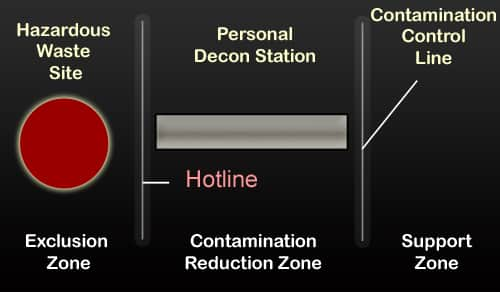OSHA HAZWOPER Work Zones
The 3 OSHA HAZWOPER Work Zones
There are three distinct work zones as defined by OSHA.
- Exclusion Zone
- Contamination Reduction Zone
- Support Zone
We'll explain the difference between these work zones and describe the functions and characteristics of each.
OSHA HAZWOPER Work Zone Classification
Exclusion Zone
The Exclusion Zone is where the actual contamination occurs or could occur. The boundary of the Exclusion Zone is called the “Hotline,” and should be clearly marked with lines, placards, hazard tape, or signs. Sometimes even physical barriers like fences or ropes are used around the Hotline to block off the Exclusion Zone.

Access Control Points are usually established to regulate the personnel and equipment entering and exiting the Exclusion Zone.
Exclusion Zones may also be subdivided into different areas of contamination based on the type or level of waste. Workers within the Exclusion Zone must be equipped with the appropriate personal protective equipment (PPE) necessary for their role or degree of hazard or exposure.
The primary activities performed inside the Exclusion Zone include:
- Mapping, photographing, and sampling
- Installation of wells
- Cleanup work
Contamination Reduction Zone
The Contamination Reduction Zone lies outside the Hotline and serves as the transition area between the contaminated area (the Exclusion Zone) and the clean area (the Support Zone).
The Contamination Reduction Zone acts as a buffer area to reduce the probability of the Support Zone being contaminated by the Exclusion Zone. While the area of the Contamination Reduction Zone that is nearest the Hotline remains contaminated, the level of contamination decreases the further away you move from the Hotline in the direction of the Support Zone.
Within the Contamination Reduction Zone is an area called the “Contamination Reduction Corridor.” This area begins at the Hotline and extends outward in the direction of the Support Zone and is the area used for performing decontamination procedures.
The activities that take place inside the Contamination Reduction Zone include:
- Evaluating results of soil and water samples taken from the Exclusion Zone
- Marking and securing the Hotline
- Monitoring meteorological conditions and the potential for contaminants to be blown out of the area
- Determining locations and levels of contamination
Support Zone
The Support Zone is the outermost zone that borders the Contamination Reduction Zone. This is where administrative and other support personnel remain in order to regulate the activities happening in the other work zones and to oversee the operation at large.
The Support Zone is often positioned upwind from the Exclusion Zone in an area that has clear visibility of all activities. The Support Zone is also generally located near resources such as power lines, roads, shelters, and water.
The Support Zone remains free of any contaminated clothing, equipment or samples, all of which must remain in the Contamination Reduction Zone until properly decontaminated.
Within the Support Zone is the Command Post, which serves as the headquarters for the entire operation, along with a medical station. The Support Zone is also where recordkeeping, data storage, inventories, maps, and other useful information is produced and stored in order to support the ongoing activity in the other two work zones.
Learn More About HAZWOPER Work Zones
HAZWOPER workers, particularly those working in the Exclusion and Contamination Reduction Zones, must first complete required training by OSHA and then continue with regular refresher training in order to remain certified.
Not sure which course to take? Use our guide to determine the level of HAZWOPER, OSHA or RCRA/DOT training needed for yourself or your employees working in a HAZWOPER work zone.

